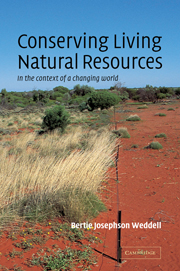Book contents
- Frontmatter
- Contents
- Preface
- Introduction: Balance and flux
- Methodology: Getting the information we need to manage living natural resources
- Part I Management to maximize production of featured species – a utilitarian approach to conservation
- 1 Historical context – the commodification of resources and the foundations of utilitarian resource management
- 2 Central concepts – population growth and interactions between populations
- 3 Central concepts – habitats
- 4 Techniques – harvest management
- 5 Techniques – habitat management
- 6 Techniques – management to minimize conflicts between pest species and people
- Part II Protection and restoration of populations and habitats – a preservationist approach to conservation
- Part III Management to maintain processes and structures – a sustainable-ecosystem approach to conservation
- Postscript
- Appendix: Scientific names of organisms mentioned in the text
- Index
3 - Central concepts – habitats
Published online by Cambridge University Press: 05 June 2012
- Frontmatter
- Contents
- Preface
- Introduction: Balance and flux
- Methodology: Getting the information we need to manage living natural resources
- Part I Management to maximize production of featured species – a utilitarian approach to conservation
- 1 Historical context – the commodification of resources and the foundations of utilitarian resource management
- 2 Central concepts – population growth and interactions between populations
- 3 Central concepts – habitats
- 4 Techniques – harvest management
- 5 Techniques – habitat management
- 6 Techniques – management to minimize conflicts between pest species and people
- Part II Protection and restoration of populations and habitats – a preservationist approach to conservation
- Part III Management to maintain processes and structures – a sustainable-ecosystem approach to conservation
- Postscript
- Appendix: Scientific names of organisms mentioned in the text
- Index
Summary
Have no doubt about it, the time has arrived when we must manage specifically for anything we want from the land. … Our renewable resources will be renewed only if we understand their requirements and plan it that way.
(Allen 1962:22)We noted in Chapter 1 that when the disciplines of forestry, wildlife management, and range management developed, their practitioners saw themselves as analogous to farmers, manipulating the environment to produce crops of desirable organisms. Their perspective led them to focus on the environmental requirements of species of interest, and they reasoned that by providing those requirements they could maximize production.
In seasonal environments, plants and animals are likely to have different requirements at different times of the year. In addition, the requirements of animals depend upon sex, age, and breeding condition. As managers came to understand this, they realized that in order to provide for a species of interest, it was necessary to understand that species' requirements throughout its entire life cycle (King 1938).
Although these developing disciplines emphasized economically valuable products, resource managers came to understand that meeting the habitat requirements of species of interest meant managing for the plant communities on which those species depended. This insight was a significant contribution. Managers realized that even the most stringent restrictions on grazing, hunting, and logging would not conserve future stocks in the face of severe habitat degradation.
- Type
- Chapter
- Information
- Conserving Living Natural ResourcesIn the Context of a Changing World, pp. 77 - 98Publisher: Cambridge University PressPrint publication year: 2002



